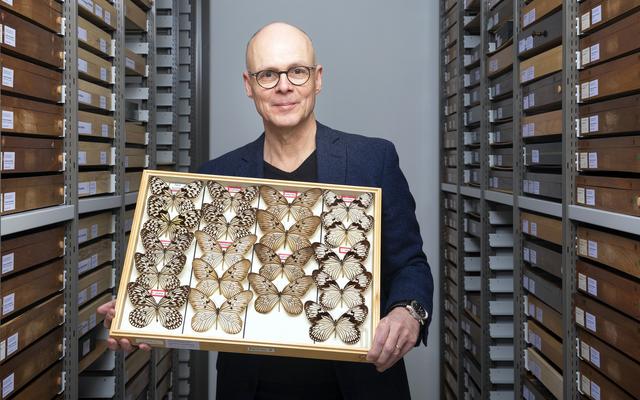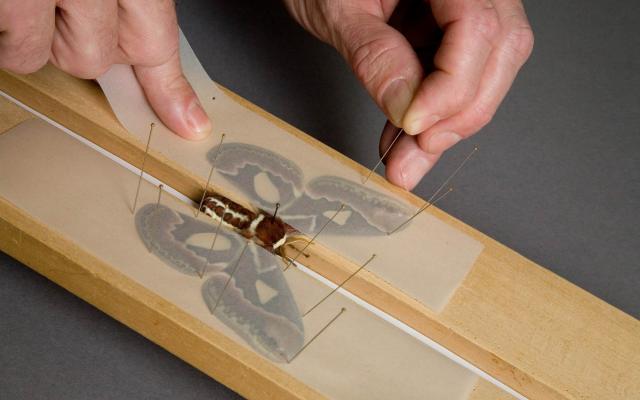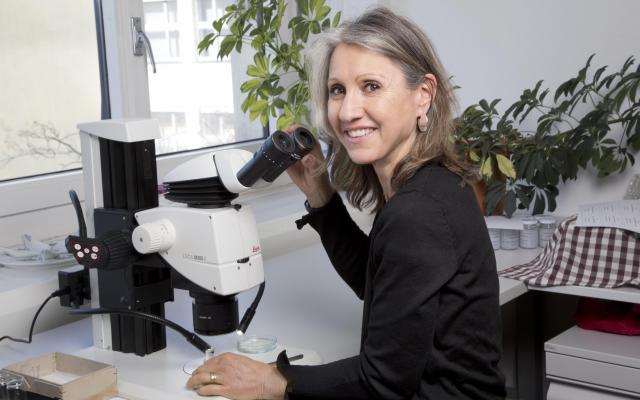The entomological collection contains first and foremost a dry collection comprising 2.5 million objects. It includes about 20'000 type specimens (incl. paratypes).
The focus is placed on the Lepidoptera (Palaearctic, Asia, South America), Coleoptera (Palaearctic) and Hymenoptera (Palaearctic, South America).
In addition to collectings from the museum’s employees, the main part of the collection consists in donations from members of the Entomological Society in Berne.
Besides, there are some significant collectors who need to be mentioned, whose collections constitute the basis for some outstanding scientific publications: Karl Vorbrodt (Macrolepidoptera, Switzerland), Hans-Peter Wymann and Peter Sonderegger (Lepidoptera: Rhopalocera, Switzerland), Werner Marggi (Coleoptera: Carabidae, Palaearctic), Hans Pochon (Coleoptera: Buprestidae, worldwide), Charles Huber (Coleoptera: Nebriinae, Palaearctic), Emile Frey-Gessner and Felix Amiet (Hymenoptera: Apidae, Switzerland).
The wet collection is by contrast relatively small. The focus lies on parasitic Hymenoptera (Chalcidoidea).
Research/ Honorary associates
- Dr. Donat Agosti
-
Formicidae
- Dr. Thomas Hertach
-
Cicadidae
- Dr. Charles Huber
-
Coleoptera: Carabidae: Nebriinae
- Dr. h.c. Werner Marggi
-
Coleoptera: Carabidae
- Dr. Andreas Müller
-
Osmiinae
- Elsa Obrecht
-
Diptera, Hymenoptera: Apidae: Bombus
- Marco Thoma
-
Hymenoptera: Apidae, Lepidoptera, Orthoptera
- Lic.phil. nat. Isabelle Trees
-
Formica rufa-Artenkomplex
- Hans-Peter Wymann
-
Lepidopterologie
The focus of the malacological collections lies on the land- and freshwater molluscs of Europe, and, on a larger scale, on the molluscs of the Palaearctic. However, due to the historical development of the museum, molluscs are collected worldwide and all groups are represented. The collection contains about 3 million pieces. There are more than 4700 type specimens (incl. paratypes) among them.
The largest part of the collection has reached the museum through donations by private collectors. The historical collection of Robert J. Shuttleworth represents the oldest, largest and most precious part. The collection mainly consists of dry shells, but there is also a growing part of specimens preserved in alcohol.
Research Associate: Dr. Adrienne Jochum, Gastropoda
Research Associates/Ehrenamtliche Mitarbeitende
- Dr. Adrienne Jochum
-
Gastropoda, speziell Höhlenschnecken
- Dr. Jeannette Kneubühler
- Dr. Eike Neubert
-
IUCN SSC Leader´s Recognition
Certificate, Mitglied IUCN Species Survival Commission, Studies
The focus of the collection lies on the spiders (Araneae) of Europe. The most important part of it is the collection of Konrad Thaler, which contains about 150‘000 specimens, mostly European. It represents the largest collection of spiders, privately assembled, in Europe.
Further significant parts of the collection apply to the Swiss collections of M. Bartels and Ambros Hänggi, the German collection of Peter Sacher, as well as the Austrian collections of Peter Horak and Christian Kropf with altogether some 10 thousands specimens.
In the last years, a number of tropical spiders has been added to it, especially Oonopidae from South East Asia. The arachnological collection presently contains 150 type specimens (incl. paratypes).
Research Associates/Ehrenamtliche Mitarbeitende
- Prof. Christian Kropf
-
Mitarbeiter Arachnologie
- Corinne Sidler
-
Mitarbeit Inventarisierung der Spinnensammlung von O. Horak




